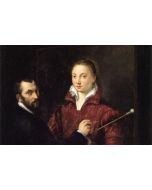Symbols and stories: saints in art
Time: 11:00 - 13:00
Location: Keeley Street

- Course Code: VB469
- Dates: 04/06/24 - 09/07/24
- Time: 11:00 - 13:00
- Taught: Tue, Daytime
- Duration: 6 sessions (over 6 weeks)
- Location: Keeley Street
- Tutor: Elizabeth Eyres
Course Code: VB469
Duration: 6 sessions (over 6 weeks)
Please note: We offer a wide variety of financial support to make courses affordable. Just visit our online Help Centre for more information on a range of topics including fees, online learning and FAQs.
What is the course about?
On this course you will learn how to recognise important saints, patron saints and key religious figures in art and consider the role and function of saints in Medieval, Renaissance and Baroque art. Discover their attributes, associated legends, martyrdoms and the development of colourful and symbolically enriched visual narratives capturing the lives and deaths of saints in art.
The final session of the course will take place in The National Gallery.
Content warning: this course includes painted and sculpted representations of martyrdoms, which may be distressing to some viewers.
What will we cover?
• How to recognize important saints and key religious figures in art; their symbols and attributes.
• Associated legends, martyrdoms and stories of popular saints in art.
• Role and function of saints in art.
What will I achieve?
By the end of this course you should be able to...
• Identify at least four saints through their attributes and/or symbols
• Recount at least one story / legend associated with popular saints
• Describe the role of saints in art.
What level is the course and do I need any particular skills?
This course is suitable for all levels.
You should be able to follow simple written and verbal instructions, demonstrations, hand-outs and health and safety information.
How will I be taught, and will there be any work outside the class?
You will be taught by lecture with slide images and you will be invited to participate in group discussion. There will be homework in this course, in the form of reading. Handouts will be available digitally via a Google Classroom. You will be invited to join the Google Classroom within a week of your course start date.
This course includes at least one visit to the National Gallery, during one of the course sessions. You will need to transport yourself to the National Gallery during the class session. Further information on this visit will be explained when the course begins.
Please note: Museum/gallery-based sessions take place during public access hours. Tutors are not able to control sound levels or behaviours of visitors outside of the course group. Unless you are a wheelchair user, and have confirmed access details with us (as levels of access can vary between galleries), you will need to be able to walk between exhibits and stand for some time while looking at them (you may bring your own portable stool if you have one, but we cannot guarantee access to any gallery stools.) If you feel you may be impacted by these environmental variations, please inform the department on humanities@citylit.ac.uk before the course begins, to discuss reasonable accommodations we can make to assist your learning in the museum space.
Are there any other costs? Is there anything I need to bring?
You might wish to purchase a notebook for taking notes. You might wish to buy some of the books on any reading list provided.
When I've finished, what course can I do next?
Art of the Northern Renaissance
Islamic Art in 25 Objects.
Liz Keevill Eyres worked as a textile designer in the fashion industry for four years and then as a magazine journalist specializing in interior design for 13 years. Her first degree was at Camberwell School of Art which she did at the same time as completing a degree in History and Art History with the Open University. Liz studied and has taught at Kingston University, where she lead modules and lectured in history of art, design history and architecture for ten years and ran study visits both at home and abroad. Liz has researched into English Modernist textile design of the 1950s and the professional practice of the provincial Edwardian architect, in particular Norwich-based architect George Skipper.
Please note: We reserve the right to change our tutors from those advertised. This happens rarely, but if it does, we are unable to refund fees due to this. Our tutors may have different teaching styles; however we guarantee a consistent quality of teaching in all our courses.
